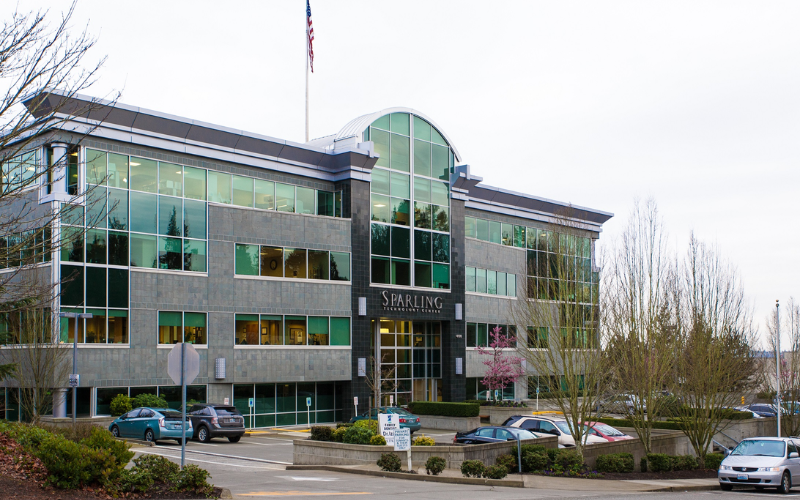Client: Lynnwood Corporate Center 2 LLC.
Dates of Service: 2003-2005
Project Summary: This steel-framed building consists of 4 levels of offices over a post-tensioned concrete-framed garage base. Exterior walls are primarily clad with stone tile, with curtain-wall and store-front window systems.
Widespread and persistent leakage began affecting the exterior walls after the building’s completion in 2000 and resisted corrective attempts.
PL: BECS Services: PL: BECS provided services in four phases.
The first consisted of an overall evaluation of the building’s exterior systems, including store-front and curtain-wall windows, tile cladding, and sub-grade concrete walls. This evaluation revealed that most leakages resulted from fundamental flaws in the design of window flashings, which were improperly configured, and lacked any drainage provisions.
This was exacerbated by an inherently vulnerable exterior tile cladding assembly. Additional leakage was also occurring at sub-grade walls, which had experienced cracking due to post-tensioned creep. In the project’s second phase, PL: BECS provided expert witness testimony in support of the owner’s effort to be reimbursed for these flaws and allow corrective work to proceed.
Next, PL: BECS developed a limited-cost approach for corrective work, and prepared construction documents and specifications defining this work. Finally, PL: BECS provided limited construction oversight and testing related to the corrective work. In-progress testing indicated that the corrective approach proved effective even under severe wind-driven rain conditions.
The Importance of Technology Centers
Entrepreneurship, innovation, and technological advancement can all benefit greatly from being close to a technology cluster. They play a catalytic role in the economy by encouraging a community of sharing and learning between businesses and individuals. These locations enable the development of unprecedented goods and services by providing access to tools, guidance, funding possibilities, and a supportive community.
The History of Sparling Technology Center
- Founding and Vision: Sparling Technology Center was founded to facilitate technological advancement through the sharing of ideas and the sharing of resources. It was established by forward-thinking business people and government officials who saw the need for a designated area to encourage and facilitate the growth of technology-based businesses. The hub’s mission is to foster an atmosphere that promotes innovation, entrepreneurship, and teamwork while contributing to the growth of the regional economy.
- Growth and Development: Since it initially opened, the Sparling Technology Center has undergone tremendous expansion and development. It has expanded its building space, attracted new and established businesses, and partnered with government organizations, Fortune 500 firms, and universities. This enlargement solidified the area’s reputation as a hub of creativity, making it a desirable location for tech startups to grow and make an impact.
Facilities & Features of Sparling Technology Center
1. State-of-the-Art Infrastructure
Businesses that place a premium on technology will appreciate the Sparling Technology Center’s state-of-the-art amenities, which have been designed with their needs in mind. The facility has state-of-the-art communication and networking systems, R&D facilities, prototyping facilities, and state-of-the-art office space. Startup founders and artists can put their ideas into action with the help of these resources.
2. Collaborative Spaces
Cooperation is the backbone of the Sparling Technology Center. The building features shared workspaces where tenants and visitors can network and collaborate on a variety of projects. Public areas like lounges, meeting rooms, and open offices are designed with collaboration and information sharing in mind. The facility encourages its tenants to work together, which promotes idea-sharing and the formation of strategic partnerships.
3. Support Services
The Sparling Technology Center is here to help businesses of all sizes get off the ground and succeed. Networking events, company development resources, mentoring programs, and access to financial resources are all examples of what may fall under this category. The hub could also be useful for finding experts, safeguarding ideas, and understanding how to comply with rules and regulations.


